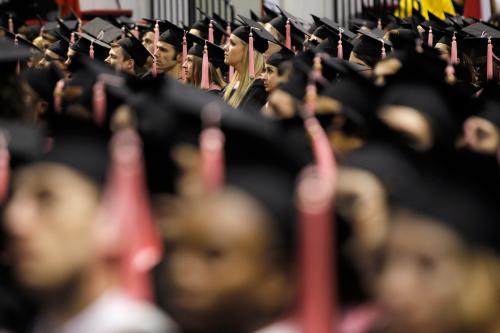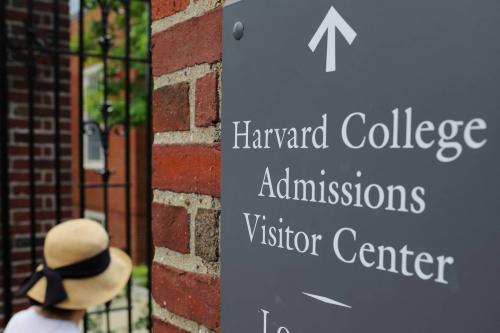The return on investment of a college education is well-documented, leading to meaningful employment, economic mobility, and even increased life expectancy. Still, only about 60% of students complete their four-year undergraduate degree within six years; far fewer complete their degrees in the expected four-year period. This pattern has not changed appreciably in 40 years.
As early as 1975, researchers were noting this problem and developing conceptual models to identify the factors that contributed to “drop-out.” The factors identified can be categorized in two buckets: student and family resources, and institutional practices. At the level of students and their families, challenges that reduce graduation rates include having lower income, lower high school GPAs, limited family support, and poor social integration, among other factors. At the institutional level, a host of additional challenges lower graduation rates. These include choices about financial expenditure on students, the depth of student advising and career education, and the overall social climate to foster a sense of belonging for all students.
This conceptual work has been followed by decades of empirical research to identify concrete investments that help students persist in their studies to graduation. Nevertheless, despite all the research and handwringing about this issue, little has changed in the last 25 years. College students who never complete their degree enter their working lives with limited college preparation for a career, not to mention often crippling student debt.
Maybe we are looking at the problem in the wrong way. Rather than focusing on who is not graduating, we can turn our attention to those who do and to those institutions that enjoy higher graduation rates than others. Let us look for positive deviants.
Identify and follow successful colleges to advance graduation rates nationally
Positive deviance posits that some individuals or institutions, facing the same challenges as their peers, still manage to find better outcomes by using uncommon behaviors and strategies. By studying these “positive deviants,” we can uncover novel insights and potentially enable greater success in peer institutions.
Using lessons from positive deviance, academic leadership can look to the institutions that have greater success rates. An early, well-known application of positive deviance was to address food insecurity in Vietnam, where researchers identified the positive-deviant families who were able to successfully nourish their children within a community where children were largely starving. Not only did this discovery help the entire community adopt the winning strategies—in this case, feeding their children high-protein shrimp and fish that many in the community believed were taboo—but also it continues to be a life-saving way of life 30 years later.
Positive deviance has also been a critical tool in improving performance among health-care institutions. My own research with colleagues identified in positive-deviant hospitals practical ways to reduce delays in life-saving treatment for people with heart attacks. The work helped to revolutionize the way hospitals organized emergency heart-attack care, significantly reducing patient mortality rates. This approach can be replicated in higher education institutions.
Examples of program success abound, but the need for systematic reform persists
A few inspiring programs for improving graduation rates from colleges have been examined over the years. Notable mentions include career intervention programs that use the My Vocational Situation (MVS) assessment for a more customized experience that matches student values with their vocational aims, or the KEY Careers program, which uses the MVS as well as online learning and on-campus programming to promote career preparation and successful post-graduate employment. Another fruitful set of programs seeks to improve campuses’ racial climates through efforts like my own institution’s Engaged Pluralism Initiative, where students, administrators, and faculty work together to foster greater inclusion and sense of belonging for students of all backgrounds. Summer bridge and transition programs, too, allow students that represent the first generation in their family to attend college to find a greater sense of belonging in higher education, and have resulted in higher graduation rates.
But these and other programs are one-offs. They are impressive as case studies, but they have not led to large-scale, systemic changes in higher education.
Academic leadership seeking to promote the effectiveness of higher education need to do better. And it should begin with improved, more actionable research. Let us refine the models predicting graduation rates and then identify the colleges and universities that have significantly higher-than-expected graduation rates—the positive-deviant institutions. Then let us study those deeply, using qualitative and longitudinal studies, to understand what distinguishes them. What are they doing to graduate substantially more students than expected given their student body profile and extant resources?
This approach of eliciting clever approaches to achieve a social goal has been used in health care successfully, conferring tremendous insights that have made a positive difference. It requires taking a deep, hard look at ourselves, using the learning tools we teach so readily to others, and taking the needed steps to change the course of higher education.
Students who begin their undergraduate degrees, often paying substantial sums of money, should be able to reap the lifetime benefits of a college education. Some of the graduation gaps can be closed with additional efforts from students and families; however, institutions of higher education can also be doing much more to close these gaps. We would do well to learn why we are failing so many students and have the courage to serve them better.





Commentary
To boost college graduation rates, look for the successful ‘positive deviants’
July 14, 2021